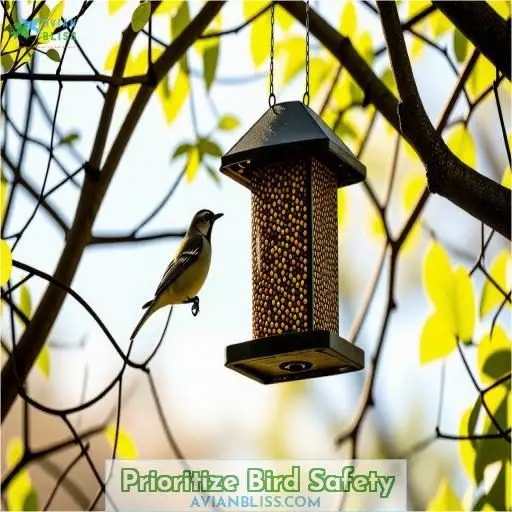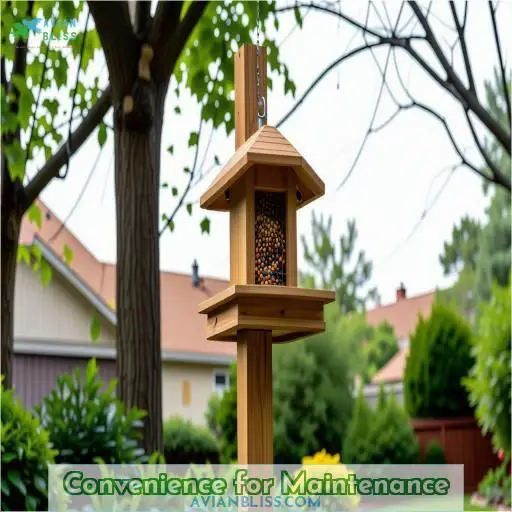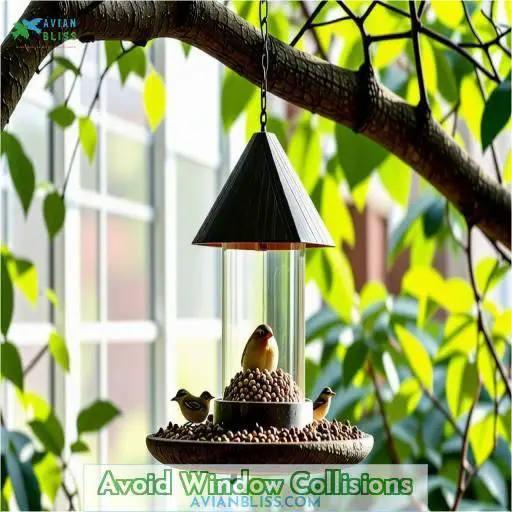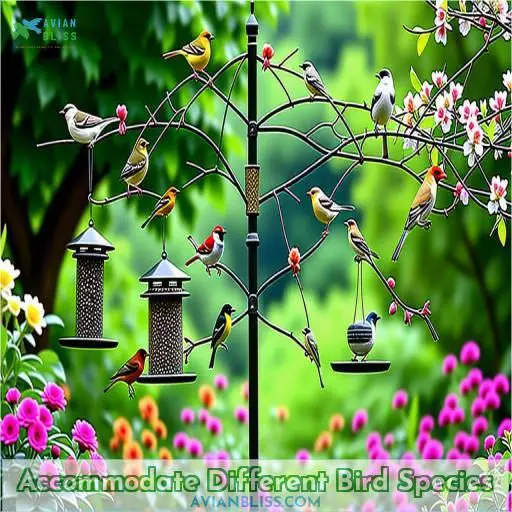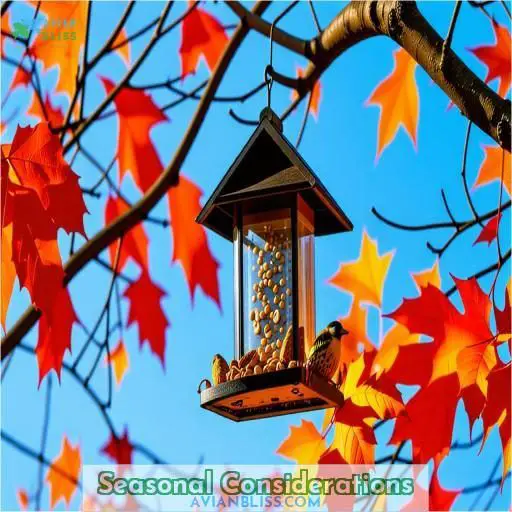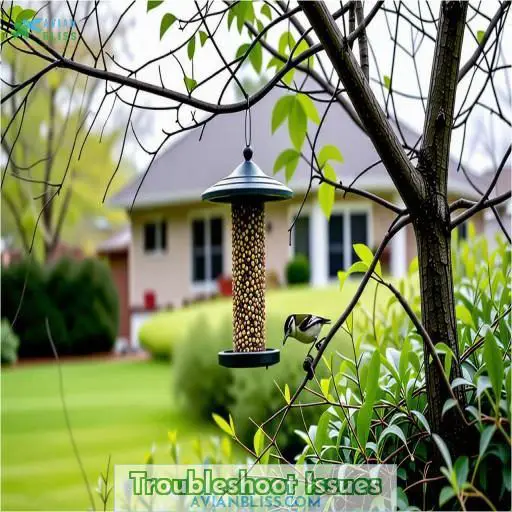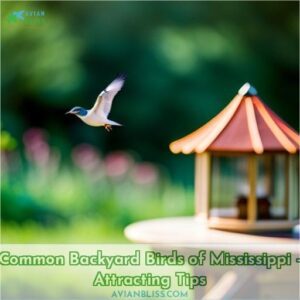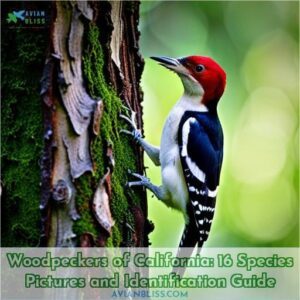This site is supported by our readers. We may earn a commission, at no cost to you, if you purchase through links.
 When positioning your bird feeder, prioritize safety by placing it near natural cover but avoiding areas with predators.
When positioning your bird feeder, prioritize safety by placing it near natural cover but avoiding areas with predators.
For good visibility, choose a spot visible from windows or seating areas, allowing you to enjoy watching birds up close.
Select an easily accessible location for convenient maintenance, steering clear of excessive seed spillage.
Deterring pests should also be considered by spacing feeders away from trees and structures.
Offer multiple feeders at varying heights to accommodate different bird species.
Seasonal considerations like shade in summer and wind protection in winter will further attract your feathered friends.
Table Of Contents
- Key Takeaways
- Where to Place a Bird Feeder?
- Prioritize Bird Safety
- Consider Visibility From Inside Your Home
- Convenience for Maintenance
- Prevent Pest Access
- Avoid Window Collisions
- Accommodate Different Bird Species
- Seasonal Considerations
- Troubleshoot Issues
- Frequently Asked Questions (FAQs)
- Where is the best spot to put a bird feeder?
- How far away from the house should a bird feeder be?
- Should bird feeders be in the sun or shade?
- Do birds like feeders high or low?
- How far should feeders be from each other?
- What types of feeders should be clustered together?
- Should feeders be placed near bird baths or water sources?
- How can feeders be made more attractive to specific bird species?
- What are some creative ways to hang multiple feeders?
- Conclusion
Key Takeaways
- Positioning feeders near natural cover like shrubs or evergreen trees provides a cozy sanctuary where birds can seek refuge from predators and harsh weather. Just steer clear of areas where cats or hawks could launch sneak attacks!
- For prime birdwatching, place feeders in clear view of your indoor hangout spots. That way, you’ll have a front-row seat to the avian acrobatics and melodious morning choruses right outside your window.
- Site feeders in an easily accessible spot, preferably at eye level for fuss-free refilling. No one wants to be doing backbends or circus contortions just to top up the seed stash.
- Cater to diverse diners by mixing up feeder types and heights. Ground-feeders like sparrows prefer a low buffet, while hummingbirds and orioles go for the high-rise nectar bar. A varied menu attracts an eclectic flock of feathered patrons.
Where to Place a Bird Feeder?
To attract birds to your feeder, place it near natural cover like bushes or trees for protection, but avoid areas with predators like cats and hawks. Position the feeder in a visible spot from inside your home for ideal viewing enjoyment, and make sure it’s easily accessible for refilling and cleaning.
Prioritize Bird Safety
To prioritize bird safety, position feeders near natural cover like shrubs or trees that provide refuge from predators.
But avoid placing them too close to dense shrubbery that harbors cats or hawks.
Make certain the feeders are securely mounted on a sturdy pole or hung from a heavy-duty hook.
This prevents them from swaying excessively or falling, which could startle and endanger the birds.
Place Feeders Near Natural Cover for Protection
To attract birds, place feeders near dense shrubs, evergreen trees, or brush piles. This natural cover offers birds a safe haven from predators and harsh weather. Opt for a spot with:
- Thick foliage for hiding
- Multiple escape routes
- Protection from wind and rain
- Proximity to your viewing area
Avoid Areas With Predators Like Cats and Hawks
To keep your feathered friends safe, position feeders away from areas frequented by predators like cats and hawks. Avoid placing feeders near bushes, trees, or fences where these predators can easily ambush birds. Choose open spaces with good visibility to deter attacks and make sure your birds can feed in peace (Source).
Ensure Feeders Are Stable and Secure
To guarantee your feeder is stable and secure, choose a sturdy hanger that can support the weight. Anti-sway mechanisms prevent swinging in the wind. Distribute weight evenly and use wind-resistant designs. Deter squirrels with baffles. For window feeders, use strong suction cups. Chains, ropes, wall mounts, and deck clamps provide versatile hanging options.
Consider Visibility From Inside Your Home
You’ll want to position your bird feeder in a location visible from the windows or seating areas inside your home. This allows you to easily observe and enjoy watching the feathered visitors as they come and go from the feeder.
Choose a Location Visible From Windows or Seating Areas
When selecting a location for your bird feeder, consider visibility from inside your home to maximize your enjoyment of bird watching.
Choose a spot that provides a clear view from windows or seating areas, allowing you to observe the feeder activity comfortably. This ensures that you can appreciate the presence of the feathered visitors while going about your daily activities.
Additionally, you can enhance the safety and accessibility of the feeder by situating it within view of your home, making it easier to monitor and maintain.
Optimize Your Enjoyment by Watching Birds Up Close
To optimize your enjoyment, position your bird feeder where you can easily view it from inside your home.
Choose a spot near a window that offers a clear, unobstructed view.
Consider installing multiple feeders at varying heights and distances for a variety of viewing angles.
Make sure the feeders are accessible for refilling and cleaning.
For added privacy and aesthetics, surround the feeding station with potted plants or a small trellis.
With a well-placed bird feeder, you’ll have a front-row seat to the fascinating world of backyard birds.
Convenience for Maintenance
For convenience, situate feeders in spots that are easily accessible for routine refilling and cleaning. Excessive seed spillage can attract unwanted pests, so select a well-drained area and consider a catch tray to minimize debris.
Select an Easily Accessible Spot for Refilling and Cleaning
To make refilling and cleaning a breeze, choose a convenient location for your bird feeders.
Position them within easy reach, ideally at eye level or slightly below.
This filling ease allows you to quickly top up seed feeders without straining your back.
For tube feeders, select a spot with ample clearance underneath to accommodate the feeder’s length.
Avoid areas prone to seed spillage, which can attract unwanted pests like squirrels.
A well-placed feeder with a squirrel baffle ensures your bird food stays fresh and accessible for your feathered friends.
Avoid Areas With Excessive Seed Spillage
To minimize seed spillage, choose a feeder location away from high-traffic areas and obstacles.
Opt for a spot with a clear perimeter to easily collect any dropped seeds.
Avoid placing feeders near garden beds or mulch, as spilled seeds can attract unwanted pests or sprout into weeds.
Prevent Pest Access
To prevent pesky pests from raiding your bird feeders, strategically position them at least 10 feet from trees, fences, and other structures.
Install a baffled pole to effectively deter determined raccoons.
For feeders hung from trees, use sturdy hooks instead of chains or ropes to keep them secure.
Vary the height of your feeders to accommodate different bird species’ preferences.
Choose feeders designed with built-in pest deterrents like weight-sensitive perches.
Avoid Window Collisions
To prevent window collisions, place feeders either within 3 feet of glass or farther than 15 feet away.
Anything in between gives birds enough space to gain dangerous speed.
Install UV tape, anti-collision stickers, or bird-friendly glass to make windows visible.
Feeders attached directly to windows are safest, as birds expect to land there.
Avoid placing feeders near reflective windows that mimic open space.
With a few simple precautions, you can enjoy your feathered friends up close without risking their safety.
Accommodate Different Bird Species
To cater to the diverse needs of various bird species, consider offering multiple feeding stations at different heights throughout your yard. This variety will attract ground-feeders like sparrows and doves near low-lying feeders, while orioles and woodpeckers can access elevated feeders or suet logs near trees.
Offer Multiple Feeding Stations at Varying Heights
To attract a wide variety of birds, offer multiple feeding stations at varying heights.
Hang tube feeders at eye level, suet feeders on tree trunks, and hopper feeders on poles.
Space feeders 10-12 feet apart for easy access.
Make sure each station is visible from your main viewing areas.
Diverse feeder density, distance, and accessibility cater to different species’ preferences, fostering a vibrant backyard ecosystem.
Experiment with feeder types and placements to discover what works best for your feathered friends.
With a little trial and error, you’ll soon have a thriving bird buffet!
Cater to Ground-feeding, Trunk-feeding, and Flower-feeding Birds
To attract a diverse array of birds, strategically place perches at varying heights.
Ground-feeding birds like sparrows and juncos prefer seed scattered on the ground or in low trays.
Trunk-feeding birds such as woodpeckers and nuthatches are drawn to suet feeders mounted on tree trunks.
Hummingbirds and orioles flock to nectar feeders hung near flowering plants.
Offer a variety of feeders at different levels to accommodate every bird’s unique feeding habits.
With a little planning, your backyard can become a thriving bird observatory!
Remember to keep seed fresh and feeders clean for the health and safety of your feathered friends.
Seasonal Considerations
Position feeders in shady spots during hot summer months to prevent seed spoilage and offer respite for birds. Additionally, provide shelter from wind, snow, and freezing temperatures in winter by placing feeders under overhangs or near structures that offer protection.
Position Feeders in Shady Spots During Summer
When positioning bird feeders in shady spots during hot temperatures, you’re creating a comfortable environment for the birds while also preserving the quality of the seeds. Shady locations can help prevent the seeds from spoiling quickly due to excessive heat exposure. To accommodate this, it’s important to find areas with natural cover or to use an overhang to shield the feeders from direct sunlight. This will help maintain a suitable temperature for the birds to feed comfortably while also preventing rapid deterioration of the seeds (Source).
| Consideration | Guidelines |
|---|---|
| Shady Locations | Choose spots with natural cover or use overhangs to shield from direct sunlight |
| Seed Preservation | Prevent rapid deterioration of seeds due to excessive heat exposure |
| Bird Comfort | Maintain a suitable temperature for birds to feed comfortably |
Provide Shelter From Wind and Snow in Winter
In winter, provide shelter from wind and snow by positioning feeders under a broad baffle or roof overhang.
This protects seed from getting buried and keeps birds comfortable while feeding.
Evergreen trees and shrubs make ideal natural windbreaks, offering year-round protection.
For ground-feeding birds, loosely stacked brush piles near feeders create a cozy retreat from winter storms.
With a little planning, you can create a welcoming winter oasis that keeps your feathered friends safe, warm, and well-fed all season long.
Troubleshoot Issues
If you’re having trouble attracting birds to your feeder, try adjusting its type, stability, visibility, or placement.
Make sure the feeder is appropriate for the species you want to attract, such as seed feeders for finches or suet feeders for woodpeckers.
Secure the feeder to prevent it from swinging or falling, and position it in an open area with good visibility for birds.
Avoid placing feeders near obstacles like windows, trees, or shrubs that could obstruct access or pose collision risks.
Keep feeders away from potential contaminants like pesticides or chemicals.
With some troubleshooting, you can create an inviting space for your feathered friends to enjoy.
Frequently Asked Questions (FAQs)
Where is the best spot to put a bird feeder?
Like artists arranging a masterpiece, position feeders strategically to welcome feathered friends: near cover for safety, with clear sightlines for your delight, and convenient for effortless maintenance.
How far away from the house should a bird feeder be?
Position bird feeders 10-20 feet away from your home’s windows to minimize bird collisions while allowing for maximum viewing. For safety, keep feeders at least 4 feet off the ground and away from potential predator hiding spots.
Should bird feeders be in the sun or shade?
Capture nature’s vibrant colors by strategically placing feeders — sunny spots will attract more feathered friends, while shady areas offer relief during sweltering days. Observe bird behavior to determine their preferred dining spaces.
Do birds like feeders high or low?
Birds prefer feeders placed at varying heights between 4-6 feet, catering to different species’ feeding behaviors. Smaller birds like low feeders, while larger birds favor higher perches. Diversifying feeder heights attracts a wider variety of feathered visitors to your backyard.
How far should feeders be from each other?
Remember the old saying Birds of a feather flock together? Aim to space your feeders at least 10-15 feet apart to accommodate different bird species and reduce crowding. This mimics the natural environment and guarantees every feathered friend can dine comfortably.
What types of feeders should be clustered together?
Cluster seed feeders near brushy areas, suet feeders close to large trees. Group similar feeders together, as birds typically prefer specific seed types or suet cakes. This attracts compatible species that won’t compete for limited resources.
Should feeders be placed near bird baths or water sources?
Yes, placing feeders near bird baths or other water sources is ideal. Birds need access to clean water for drinking and bathing, so combining these elements creates an appealing environment for avian visitors.
How can feeders be made more attractive to specific bird species?
If you want chickadees, offer black oil sunflower and suet feeders near trees. For cardinals, place hopper feeders with mixed seeds in open areas. By understanding bird species’ preferences, you can tailor your setup to attract specific backyard visitors.
What are some creative ways to hang multiple feeders?
Mount feeders creatively on decorative trellises, hangers, or poles at varying heights. Suspend feeders from sturdy tree branches or railings using tough ropes or chains. Get creative with placement to attract diverse bird species.
Conclusion
Ultimately, positioning your bird feeder strategically optimizes the chances of attracting diverse feathered friends. As the adage goes, If you build it, they’ll come. By carefully considering where to place a bird feeder based on safety, visibility, accessibility, and accommodation for various species, you create an inviting sanctuary for winged visitors to frequent your outdoor space.

